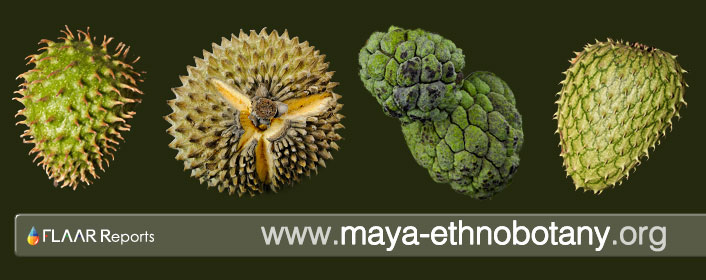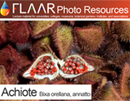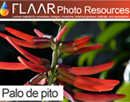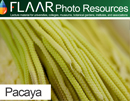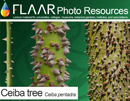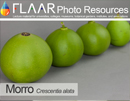When time and funding permit, each flower (each plant species) will have its own page, and its own PDF, and eventually its own PPT so that professors and students have plenty of material on Guatemala (and Honduras, etc) to study.
Heliconia adflexa, Coban, Guatemala, Hotel Monja Blanca, FLAAR, by Nicholas Hellmuth
This space is for flowers
we have recently found and photographed.
|
| Share
|
| Manicaria saccifera, confra palm, Municipio de Livingston, Izabal |
Manicaria saccifera Gaertn. in Guatemala only in coastal zonesYou see massive cohune (Corozo) palms as you drive into Izabal from the less wet areas south. And Attalea cohune and/or close relatives are in most hillside cow pastures between Livingston and Plan Grande Tatin. But around the coastal beach area of Buena Vista and brackish inland creek areas of Tapon Creek, and Taponcito Creek nature reserves, there are only a few areas with multiple examples of corozo palm. Same with guano palm: not many here near the coast. Is sea breeze and brackish water something these palms are not keen on? Yet on other parts of the Caribbean shore there are majestic growths of corozo palm. So we have a lot more to learn about. But in the meantime, where there are not many Peten hillside palms in the seasonally inundated flatlands of Izabal there are thousands of Manicaria saccifera palms, called confra. These palms have impressive potential for housing materials. Where else can you find Manicaria sacciferaSo far this confra palm is listed primarily for the sea coastal areas of Belize, Izabal, Honduras and down south into South America. I am thus surprised not (yet) to find it in sea coastal areas of Quintana Roo, Yucatan, Campeche, Tabasco or Veracruz (Mexico). This raises the question of what is in the sand and soil of Belize and Izabal that is missing in Quintana Roo and elsewhere around the Caribbean? 90% of the maps of botanical gardens and websites are totally incorrect for distribution: these maps are just colored blobs that show an entire country with green when a plant is found even only in one small area of that country. www.plantsoftheworldonline.org/taxon/urn:lsid:ipni.org:names:668116-1 This is misleading to students and scholars who do not know the plant in-person or the ecosystems of the country that is blobbed with the supposed total presence of a plant. The location for this plant is coastal (for Guatemala and Belize) and the map should show this in an acceptable manner. Manicaria saccifera, confra palm has so much potential Local Mayan people say clearly that Manicaria saccifera, confra palm is significantly better than other palms for thatching their homes. We will have a separate page and separate photo album of the confra palm as roof thatch by end of this year. Chemists and engineers suggest that the fibers of Manicaria saccifera, confra palm can be used to manufacturer panels for houses and even airplanes (Porras and colleagues, see bibliography). We first noticed this palm earlier this year since I am not (yet) aware of it in Peten or Alta Verapaz. We will be doing a lot more fieldwork in Izabal during the coming year and will be reporting back. Our PDF (photo album; photo essay on Manicaria saccifera) will be ready in a week or so. Bibliography, books, articles, web sites: List of Suggested Reading on Manicaria saccifera, confra palm
Suggested web pages www.backyardnature.net/yucatan/manicaria.htm www.gbif.org/es/species/2735044 www.palmweb.org/cdm_dataportal/taxon/ce04443e-bf1a-4e9f-aa57-35927147d0ef http://recursos.normalpopayan.edu.co:8983/wikipedia_es_all_2017-08/A/Manicaria.html www.theplantlist.org/tpl1.1/record/kew-119702 http://tropical.theferns.info/viewtropical.php?id=Manicaria+saccifera
First posted October 23, 2020. |
Parque Nacional Yaxha, Nakum and Naranjo
Carnivorous Plants
Plants of Municipio de Livingston, Izabal
- Acrostichum danaeifolium, giant leather ferns
- Bellucia Pentamera
- Bibliography on Grias cauliflora
- Bibliography on Licania platypus
- Bibliography on Mangle negro (Avicennia germinans) L.
- Bibliography on Montriacardia arborescens
- Bibliography on Typha domingensis and Thypha latifolia
- Conocarpus erectus, white mangrove
- Edible Wetlands Plants, Hotel Tortugal
- Heliconia latispatha
- Heliconia wagneriana
- Manicaria saccifera Confra palm
- Neotropical trees of Guatemala need protection
- Nymphoides indica, waterlily flowers
- Pachira aquatica, zapoton
- Bibliography on Pithecellobium Mart., Neotropical trees of Mesoamerica
Ecosystems, Wetlands Aquatic Plants
Smartphone Camera Reviews
Bushes and small trees
Fungi and Lichens
Orchids
- Bibliography Bletia purpurea, aquatic orchid
- Bibliography, Epidendrum radicans
- Bibliography on Habenaria Orchids from Yaxha
- Bibliography, Lycaste virginalis var. alba.
- Bibliography, Macroclinium bicolor
- Bibliography, Prosthechea cochleata
- Bibliography Sobralia macrantha, Lirio de San Juan
- Bibliography, Sobralia xantholeuca
- Bibliography on Terrestrial shade orchids from Guatemala
- Bibliography on Terrestrial sunny orchids from Guatemala
Botanical Terms
Maya and Aztec flavorings for cacao, cocoa, chocolate
- Achiote, Bixa orellana
- Bibliography on Achiote, Bixa orellana
- Bibliography on Esquisúchil, Bourreria huanita
- Bourreria huanita
- Cassia grandis, bucut
- Chile Chocolate
- Chile Chocolate (Capsicum annuum var accuminatum)
- Chiranthodendron pentadactylon
- Cymbopetalum penduliflorum
- Guazuma ulmifolia
- Haematoxylum brasiletto
- Piper auritum, hoja santa
- Piper species
- Quararibea funebris
- Sterculia apetala, castaño
- Tagetes sp., Marigold
- Talauma, a variant of Magnolia
- Vanilla orchid
- Virola and nutmeg
Cacao, cocoa, chocolate
Consulting cacao & Theobroma species
Tobacco Ingredients of Aztec & Maya
Trees of Mesoamerica
- Bibliography on Acacia dolichostachya, Wild tamarind
- Bibliography, Bellucia costaricensis
- Bibliography, Bucida buceras
- Bibliography on Coccoloba belizensis Standl.
- Bibliography on Cojoba sp. and Cojoba arborea
- Bibliography, Ficus.
- Bibliography on Haematoxylum campechianum and H. brasiletto
- Bibliography on Hibiscus pernambucensis
- Bibliography on Ipomea murucoides
- Bibliography on Lacmellea standleyi, lechemiel
- Bibliography on Leucaena leucocephala
- Bibliography on mangle rojo (Rhizophora mangle)
- Bibliography on Manzanillo, Alseis yucatanensis Standl.
- Bibliography on Matilisguate, Tabebuia rosea
- Mangrove swamp Trees
- Bibliography on Ruagea insignis
- Bibliography on Pterocarpus officinalis
Bombacaceae, Bombacoideae
Tropical Fruits of the Maya
- Avocado Hass
- Bibliography on Coloc, Talisia floresii
- Bibliography, Dichogamy of avocado species
- Bibliography on Guayo, Talisia olivaeformis
- Bibliography on Laetia thamnia, Bakelac
- Bibliography on Maracuyá, Passiflora quadrangularis L.
- Bibliography on Punica granatum L., Granada
- Cashew
- Cuajilote, Parmentiera aculeata
- Granada
- Guanabas and Annonas
- Guava, Guayaba, Psidium guajava L
- Introduction to Papaya
- Nance a fruit of prehispanic Guatemala
- Passion flowers and fruits
- Passion flower, giant fruit
- Talisia floresii, Sapindaceae
- Carica Papaya Bibliography
Tropical Nuts
Spices, condiments, food coloring
Medicinal Plants
- Aristolochia, The largest flower in Guatemala, Bibliography
- Asclepias curassavica, bibliography
- Bibliography on Ciricote, Cordia dodecandra
- Bibliography on Contrahierba, Dorstenia contrajerva
- Bibliography on Falso hibisco, Malvaviscus arboreus
- Bibliography on Huele de noche, Cestrum nocturnum
- Bibliography on Lirio araña, Hymenocallis littoralis
- Bibliography on Roble Prieto, Ehretia tinifolia
- Bibliography, Tithonia diversifolia
- Canak
- Calliandra general info
- Guava, Guayaba
- Magnolia and Taluma
- Mayan medicinal plants
- Piper
- Tecomasuche, Coclospermum vitifolium
- Bibliography on Sufricay, Malmea depressa
- Bibliography on Wigandia urens
Underutilized edible plants
Edible Plants of the Mayan World
- Acacia, subin, bullhorn acacia
- Bibliography, Annona muricata
- Bibliography, Annona purpurea
- Bibliography, Annona reticulata
- Bibliography on Chipilín, Crotalaria longirostrata
- Bibliography on Chirimoya, Annona squamosa
- Bernoullia flammea
- Canna indica, tamale wrap
- Cuchamper, Gonolobus
- Guava, Guayaba
- Bibliography, Gonobolus sp.
- Bibliography, Parmentiera aculeata
- Pacaya palm Chamaedorea tepejilote
- Split leaf philodendron, Monstera deliciosa
Plants and trees used to produce incense
Utilitarian Plants
- Bibliography, Acacia farnesiana
- Bibliography on Aechmea bromeliifolia
- Bibliography on Agave americana
- Bibliography, native Agave species from Guatemala
- Bibliography on Anthurium crassinervium (Jacq.) Schott
- Bibliography on Balsa, Ochroma pyramidale
- Bibliography on Bamboo, Guadua longifolia (E.Fourn) R.W.Pohl
- Bibliography, Crescentia alata
- Bibliography, Crescentia cujete
- Bibliography on Hule, Castilla elastica
- Blepharidium guatemalense, irayol blanco
- Crescentia alata, Crescentia cujete
- Tecomasuche, Coclospermum vitifolium
- Bibliography on Coxte, Colubrina arborescens
- Bibliography on Madre cacao, Gliricidia sepium
- Bibliography on Tillandsia usneoides
